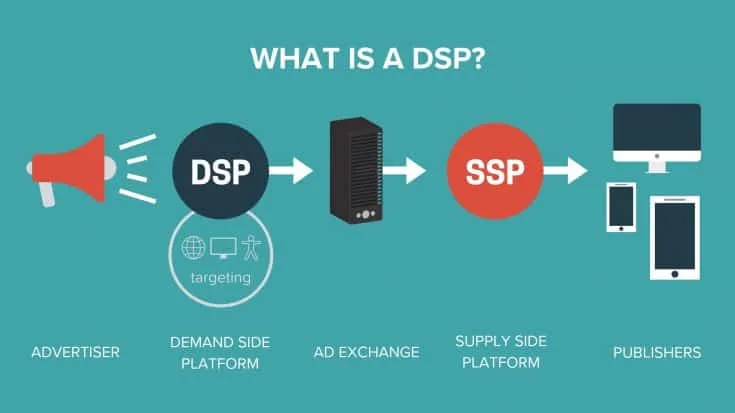What is a DSP?


In the digital advertising world, DSP stands for Demand-Side Platform.
In English, a Demand-Side Platform is cloud software that allows advertisers or ad agencies to purchase and manage digital ad campaigns, in real time, across millions of websites.
The DSP is the advertisers’ counterpart to the SSP, or Supply-Side Platform (if you’re wondering “what is an SSP,” we wrote about that too), on the publishing side.
Think of it this way:
A DSP is a more complex version of Google AdWords or Facebook. While there are similarities, their differences are what make all of these important platforms for advertisers.
In Google AdWords or Facebook (examples we’re all mostly familiar with), an advertiser typically has an ad / message they want to send out to a specific audience. This audience could have specific demographics, geography, or simply search for a keyword.
In a DSP, demographics are significantly harder to target as there usually is no user information such as gender / age / etc (unlike Facebook). Instead, a DSP can target the content of a site, audience data they buy from a third party, or an advertiser’s own user data.
You enter a daily, monthly, yearly, etc. budget; in the case of Facebook and Google AdWords, what you’re willing to pay per click/user. For a DSP, it’s usually per 1,000 impressions.
In each of these situations, you’re telling Facebook, AdWords, or DSP that you want to bid on impressions that match your targeting criteria.

Now, when a user searches for the content you’re targeting, or happens to match the user profile you wanted to target, you’re entered into an auction on the DSP side.
In all likelihood, you’re not the only advertiser that wants to target that user, or that individual ad impression, so the DSP is going to run its own auction.
They’re going to have a lot to consider.
Who’s willing to pay the most isn’t the only variable; How respective campaigns are tracking to spend their budgets and other factors also enter the equation.
Whatever the DSP decides is its top bid — this happens in fractions of a second — is what it sends to the SSP, which in turn takes all the DSP bids and selects the highest CPM to “win.”
So you can think of a DSP as its own mini-auction, the winner of which moves on to the SSP auction. Then, funny enough, thanks to header bidding, there’s yet another auction.
That’s right. The auction of auctions of auctions.
Crazily, you’ll never notice any of this. Whenever you visit a website, each advertisement on the page is served after these auctions took place, in real time. Milliseconds.
DSPs are able to do this because they know your targeting requests ahead of time, and don’t have to relay that information to the advertiser for each ad request. This allows them to respond almost instantaneously, returning bids to the SSP (and the publisher) in no time.

Given how intertwined they are, you might ask why both DSPs and SSPs are necessary. Why couldn’t the advertiser just send all pertinent data to the SSP?
Because, in short, that’s not what SSPs were built for, and while both platforms behave similarly in some respects, they’re designed to achieve different goals.
Think of it like a real estate transaction. Both buyers and sellers have different goals, and thus want their own representation, even though they need one another.
In our industry, the buyer, or advertiser, wants ad inventory as cheaply as possible. The seller, or the publisher, wants to sell that inventory for as much as possible.
An SSP’s goal is to deliver you the highest CPM for each ad impression. Conversely, the DSP sets out to pay the lowest CPM it can while still winning the impression.
DSPs also factor in many other variables besides the CPM, as we mentioned earlier. DSPs optimize for win rates, bid rates, viewability, click-through rates, frequency caps, flight dates and many other post-auction metrics that SSPs don’t have to even think about.
Basically, in addition to representing opposite sides of the transaction, DSPs are more specialized and tailored towards the buy side than most SSPs would be capable of.
Of course, there are some larger companies that own both DSPs and SSPs, such as Google, who must follow strict guidelines to keep the businesses separate.

Very valid question.
Advertisers will use both DSPs and AdWords/Facebook for the same campaign, but typically with different campaign goals.
AdWords / Facebook are more for what we call “direct response” (DR) campaigns, where advertisers look for immediate action by the user (such as an ad click, phone call, purchase).
This is called “bottom of the funnel” advertising, when a user is ready to purchase.
DSPs are more used for branding, or getting an advertiser’s message out. KPIs would range more towards viewability, interaction with the ad / advertiser’s site vs. a purchase or completed action. However, DR campaigns do come through here as well.
This is “top of the funnel” advertising, when a user is made aware of the advertiser / campaign.
Of course, this isn’t the case 100 percent of the time, but is a good rule of thumb when looking at the two platforms.
Remember our example above?
Well, it turns out DSPs offer more advanced targeting than AdWords or Facebook. There’s the concept of retargeting (a topic for another blog post), where you can target people that have been to your site or shopped at your website using a “tracking pixel.”
This popular technique allows you to upload a list from CRM (customer relationship management) platforms like SalesForce, and target just your own customers.
How does all that complex targeting work?
Much of it is powered by a combination of DMP (data management platforms) and the ability to user sync. These two intricate and complex concepts are how a DSP matches users browsing your website with the data their advertisers want to target.
DSPs can also target site content, based on domain and IAB classification.

In a word (or two): A lot. The DSP is who actually purchases the impressions in these real-time auctions on behalf of the advertisers. DSPs collect all the payments, and they pay the SSPs, who ultimately pay the publishers for the impressions.
They’re also optimizing for the KPIs (Key Performance Indicators) and reporting them back to the client. They handle tasks such as whitelisting (deciding which domains they run on) surfacing new opportunities for advertisers like Private Marketplace (PMP) deals and more.
In short, DSPs do a LOT in this ecosystem.
AdWords and Facebook can be considered DSPs (though they don’t typically buy through SSPs), but because of how specialized they are and campaign goals, the programmatic advertising industry tends to not view them as such.
People in the programmatic trenches, so to speak, typically look to Google’s Display & Video 360 (DV360) or The Trade Desk when talking about DSPs.
The list definitely goes far beyond that, including Adobe Advertising Cloud (formerly TubeMogul), Amobee (formerly Turn), DataXu and many more.
All in all there are over 100 DSPs, many of whom you’ve never heard of, but many with their own unique angle that differentiates them in this marketplace.
Stay up to date with the latest from Mediavine
As the digital advertising landscape evolves, the need for effective data management and compliance has never been more critical. As part of our commitment to providing exceptional solutions for our …
Welcome to the much-anticipated release of the fifth-annual edition of “The Best eCPM Days of the Year” calendar. Each year, we analyze historical trends to provide publishers with a graphical …
“Let’s talk about politics.” We know. This is a phrase absolutely no one wants to hear uttered around the dinner table or backyard barbecue these days. But hear us out. …